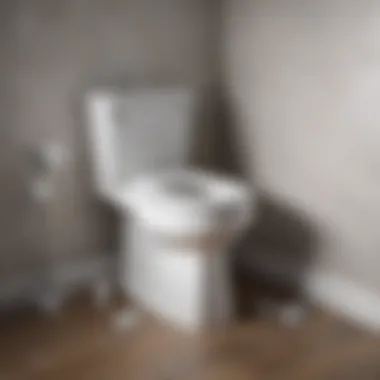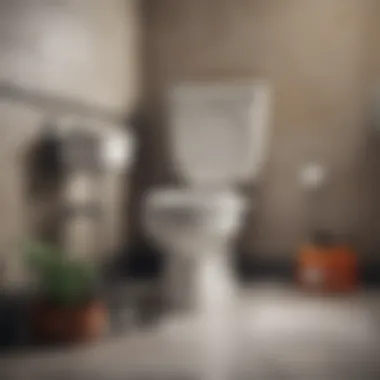Understanding the Causes of Toilet Clogs and Solutions


Intro
Toilet clogs are often a frustrating aspect of modern household management. The significance of understanding why clogs happen goes beyond mere inconvenience. By comprehending the factors contributing to clogging, homeowners can take proactive steps to improve their plumbing systems. This article will delve into the complexities of toilet clogs, highlighting design issues, user behavior, and common household products that may exacerbate clogs. We will also discuss preventive measures and maintenance practices that can help keep toilets functioning smoothly.
Identifying Common Causes
- Design Flaws: Certain toilet models come with inherent design weaknesses. Compromised flushing efficiency or poorly designed trap ways may lead to blockages.
- User Behavior: Flushing non-flushable items such as wipes, cotton balls, and excessive toilet paper can easily lead to clogs. Awareness of bathroom habits plays a crucial role.
- Household Products: Some cleaning products can react adversely with plumbing systems. Items like thick cleaners can coat pipes, causing gradual buildup over time.
By focusing on these aspects, we can start to form a clearer picture of what often leads to clogs.
The Role of Design Flaws
Design Flaws
The architecture of a toilet significantly influences how well it functions. Some toilets have small trap ways or low water volumes, making them more susceptible to clogs. Sanitary fixtures that lack optimal drainage design can lead to more frequent issues.
Unique Home Features
In unique architectural settings, such as older homes, plumbing may not align with current standards. Cast iron pipes, for instance, may have corroded interior walls creating rough surfaces where debris can accumulate, resulting in clogs.
Historical Significance
Historically, plumbing systems were not adequately planned for the demands of modern households. Studying these past designs provides valuable insights in understanding ongoing problems.
Strengthening Preventive Measures
To effectively mitigate toilet clogs, homeowners should adopt shared responsibilities in maintaining their plumbing. Here are several strategies:
- Educate all household members about what can and cannot be flushed.
- Use high-efficiency toilets equipped with better flushing technology.
- Conduct regular inspections, checking for leaks and buildup.
By implementing these measures, clogs can often be avoided before they escalate.
Closure
Toilet clogs, while common, often result from several discernible causes. By dissecting the factors such as design flaws, user habits, and the products we use, it is possible to create a more effective approach to toilet maintenance. Recognizing these contributors empowers homeowners, setting them on a path toward a more efficient plumbing system.
Intro to Toilet Clogs
Toilet clogs often emerge as a frustrating yet common issue in many homes. When understanding this topic, it is essential to recognize that clogs signify underlying problems. These problems can vary by household and may reflect both user habits and systemic design flaws. Knowing the reasons behind these disruptions can lead to better management and prevention strategies.
Focusing on the causes of toilet clogs reveals critical insights about design, user behaviors, and the products we commonly use. Such an understanding can equip homeowners with the knowledge to mitigate problems before they escalate. Clogs can lead to costly repairs and stress, making it vital to grasp their origins.
Here are some key points to consider about toilet clogs:
- Household Impact: Clogs can disrupt daily routines and affect sanitation.
- Cost Implications: Resolving clogs often involves financial investment, both in repairs and potential plumbing upgrades.
- Preventative Measures: Educating oneself on how to avoid clogs enhances plumbing longevity.
As we delve deeper into the causes of toilet clogs, it becomes clear that prevention and awareness enrich the overall quality of home maintenance. This article serves as a guide, shedding light on various contributing factors and offering best practices to keep plumbing systems running smoothly.
The Mechanism of Toilet Functionality
Understanding the mechanism of toilet functionality is vital for grasping the complexities behind toilet clogs. Each component within a toilet system plays a key role in ensuring that waste is efficiently removed and that water flows properly. Recognizing how these parts work together can help in identifying issues that lead to clogs, thereby allowing homeowners to take proactive steps to maintain their plumbing systems.
Components of a Toilet System
Every toilet consists of several essential components, which include:


- Tank: The upper section that holds water, ready for flushing.
- Bowl: The lower part that collects waste.
- Flapper: A rubber seal that releases water from the tank into the bowl when flushed.
- Fill Valve: Responsible for refilling the tank with water after flushing.
- Overflow Tube: Prevents overflow by redirecting excess water back to the bowl.
These components must operate in synergy for the toilet to function properly. Any dysfunction in one part can lead to ineffective flushing or clogs.
How Different Parts Contribute to Flushing Efficiency
Each component is integral to flushing efficiency. The flapper, for instance, controls the timing and volume of water that enters the bowl. A worn or misaligned flapper may lead to insufficient water flow, weakening the flush and increasing the likelihood of clogs.
The fill valve ensures that the tank reaches the optimal water level for a powerful flush. If the fill valve fails to close, it can cause continuous running, wasting water and potentially leading to larger plumbing issues. The overflow tube acts as a safety feature, obviating the risk of overflowing the tank and causing water damage.
To summarize, maintenance and awareness of these components can significantly enhance toilet performance. Homeowners should regularly inspect these parts, ensuring they are functioning as intended to prevent clogs and maintain overall plumbing health.
Common Causes of Toilet Clogs
Understanding the common causes of toilet clogs is essential in maintaining a smoothly functioning bathroom. Clogs disrupt the daily routines of many households, often leading to unpleasant experiences and costly repairs. By recognizing what contributes to these issues, homeowners can implement strategies to prevent such blockages. This section will explore specific elements that cause clogs, detailing their implications and considerations.
Excessive Toilet Paper Use
Using too much toilet paper is a frequent contributor to toilet clogs. Most toilets are designed to handle a specific amount of paper per flush. When this limit is exceeded, the absorption properties of toilet paper can cause it to clump together, blocking the passage.
Homeowners should consider:
- Alternatives: Using thinner toilet paper or less paper can help.
- Flush Frequency: It's beneficial to flush more frequently when using larger amounts of paper.
These simple changes can greatly reduce the chances of clogs.
Inappropriate Items Disposed in the Toilet
Many people mistakenly dispose of items in the toilet that do not break down easily. This includes:
- Facial tissues
- Cotton swabs
- Feminine hygiene products
- Baby wipes
These items do not dissolve in water and can create blockages. It's critical to have a clear understanding of what can be safely flushed. Educating household members about proper disposal habits can lessen the risk of clogs significantly.
Hair and Other Debris Accumulation
Hair often accumulates in toilets, especially in households with long hair. When combined with soap scum and other bathroom debris, this can lead to serious clogs. To avoid this, set up some preventive measures:
- Regular Cleaning: Clean the toilet regularly to prevent hair buildup.
- Drain Screens: Use drain screens to catch hair before it enters the plumbing system.
By controlling what goes into the toilet and maintaining cleanliness, the potential for hair-related clogs decreases.
Flushing of Foreign Objects
Accidental flushing of foreign objects is another major cause of toilet clogs. This often occurs with children who may flush toys or other non-flushable items. To address this problem:
- Supervision: Keep an eye on young children while they use the bathroom.
- Signage: Place signs reminding everyone what should not be flushed.
Implementing these measures can greatly reduce the incidence of these clogs, ensuring that the toilet functions properly.
"Preventing clogs is often about changing habits and understanding basic toilet functionality."
Each of these common causes presents an opportunity for homeowners to take action. Understanding these elements can empower individuals to maintain the efficient operation of their toilets and prevent costly plumbing appointments.
Environmental Factors Contributing to Clogs


Addressing environmental factors is vital in understanding the broader context of toilet clogs. Many homeowners may not recognize that issues often arise from external elements. Water quality and the condition of pipes play significant roles in clog formation. By grasping these components, it becomes easier to institute measures for long-term maintenance and performance.
Water Quality and Mineral Build-Up
Water quality is more than just a convenience; it can affect plumbing systems profoundly. Hard water, which contains high levels of minerals such as calcium and magnesium, can lead to the accumulation of mineral deposits within pipes and toilet components. Over time, this accumulation narrows pipes, impeding the flow of waste and contributing to clogs.
Regularly monitoring and testing water quality is advisable. Homeowners can use water softeners to minimize mineral presence. This proactive step not only benefits toilets but also enhances the longevity of other plumbing fixtures. Additionally, replacing corroded parts can prevent clogs induced by mineral build-up within the toilet mechanism.
Pipes and Sewer Line Integrity
The integrity of pipes and sewer lines significantly contributes to the clog issue. Old, damaged, or improperly installed pipes can create bottlenecks for waste flow. These types of obstructions can lead to serious clogs, effective increasing the likelihood of backflow and other plumbing failures.
Regular inspections of plumbing systems can help identify potential weak points. Homeowners should be especially mindful of signs of wear, such as leaks or unusual odors. Repairing or replacing can avert larger blockages down the road. Furthermore, employing professional sewer line cleaning services may also be beneficial. This can clear out build-up that might not be immediately visible to the naked eye.
Understanding the environmental factors is crucial for anyone looking to maintain a functional and healthy plumbing system.
By focusing on water quality and the structural integrity of pipes, homeowners can diminish the risk of clogs. Adopting these practical considerations translates into a more reliable plumbing experience, safeguarding against unexpected plumbing issues.
User Behavior and Clog Prevention
Understanding user behavior in relation to toilet maintenance is crucial for preventing clogs. The actions and habits of household members can significantly affect the functionality of the toilet system. Education and best practices serve not only to reduce the occurrence of clogs but also to enhance the overall efficiency of plumbing systems. Here, we will delve into the significance of user behavior and how it can lead to more effective clog prevention.
Educating Household Members
Educating household members about what can and cannot be flushed is a foundational step in preventing clogs. Many people still mistakenly believe that toilets can handle a wide variety of materials. Imparting knowledge about proper disposal practices can minimize the risk of clogs. For instance, it is important to communicate that flushing excessive toilet paper, sanitary products, or any foreign objects can overwhelm the system.
One effective approach is to hold discussions or workshops focused on plumbing basics. Engaging members in a conversation about the toilet’s functions and limitations reinforces their understanding. Consider utilizing visual aids, like diagrams, to highlight the plumbing system and the typical pathways that waste travels. Awareness can lead to more mindful habits.
"An educated user is the best ally in clog prevention."
Implementing Best Practices
Implementing best practices around toilet usage is equally essential. Simple habits, such as using less toilet paper per flush or using a trash can for inappropriate items, can significantly reduce clogging incidents. Encourage household members to flush only when necessary and to use the toilet for its intended purpose only. These small adjustments can go a long way in maintaining plumbing health.
Here are some recommended best practices to follow:
- Limit Toilet Paper: Teach users to use a reasonable amount of toilet paper. The fewer materials flushed, the less risk of clogs.
- Avoid Flushing Foreign Objects: Make it clear that objects like toys, wipes, or dental floss should never be flushed. Provide a designated bin for disposable items.
- Monitor Water Usage: Encourage shorter flushes and periodic checks on the toilet to ensure it is functioning as intended.
- Routine Checks: Encourage regular inspections of toilet systems. Identifying issues early can lessen the likelihood of blockages.
By embedding these habits into daily routines, households become better equipped to avoid clogs. Keeping communication open and reinforcing these behaviors over time leads to a proactive approach in toilet maintenance.
Impact of Toilet Design on Clogs
The design of a toilet plays a crucial role in its functionality and propensity for clogs. Many people may overlook this aspect when considering plumbing problems, yet the relationship between toilet design and clogging is significant. Several elements affect the flushing capability, water flow, and ultimately, how prone a toilet is to impediments.
Flushing Mechanism Types
The flushing mechanism of a toilet can greatly influence how effectively waste is removed. Various types of flushing systems exist. Some include:
- Gravity Flush: This is the most common type of mechanism. It uses gravity to pull water from the tank into the bowl. While generally effective, if not designed properly, it can fail to dislodge debris, leading to clogs.
- Pressure-Assisted Flush: This system uses compressed air to expel water into the bowl. Although it offers stronger flushing power, any design flaw could lead to leakage, which could exacerbate clogs over time.
- Dual Flush: This mechanism allows for low and full flush options. It promotes water conservation but may lead to incomplete flushes if not utilized correctly, hence increasing the chances of clogs.
These mechanisms must be efficiently integrated into the overall toilet design. Maintaining a proper balance between flush power and water conservation is essential. It affects how effectively a toilet can handle waste products, and thus, how often clogs occur.
Toilet Bowl Shape and Size
The shape and size of a toilet bowl also carry importance in clog prevention. A standard toilet bowl is round, but elongated models are available. Different shapes can impact:


- Surface Area: A wider bowl often allows waste to flow through more easily. This means there is less chance for build-up. Conversely, narrower bowls may restrict flow, leading to blockages.
- Water Levels: Many designs ensure the right amount of water is present at all time. Inadequate water in the bowl can result in inefficiencies during flushing. Insufficient water means waste may not be pushed through the commode as it should.
- Angle of Design: The angle of the toilet drain also matters. If designed improperly, it can create an upward curve, which may trap debris and contribute to clogs.
As homeowners, awareness of these design aspects can guide better purchases when selecting toilets. Acquainting oneself with various flushing mechanisms and bowl designs may lead to long-term satisfaction and reduced plumbing issues.
In summary, toilet design is a pivotal factor in understanding clogs. By recognizing how design choices influence flushing efficiency and waste removal, homeowners can make informed decisions to mitigate clogging issues.
Maintenance Strategies for Preventing Clogs
In the realm of plumbing, preventive maintenance plays a crucial role in ensuring the proper functioning of toilets. Adopting effective maintenance strategies can significantly minimize the occurrence of clogs. By allocating time and resources to systematic inspections and cleaning, homeowners can maintain a healthier plumbing system, thus avoiding costly repairs and inconveniences associated with toilet clogs.
The benefits of implementing these strategies extend beyond immediate results. They also help in optimizing the longevity of the toilet components and enhancing overall efficiency. It is essential to consider the best practices that fit one’s specific home environment. Regular attention to these details can transform a potential headache into manageable upkeep.
Regular Inspections
Conducting regular inspections of your toilet is vital to catch early signs of potential clogs before they escalate. A systematic check-up can involve inspecting the toilet hardware, such as the flush mechanism, valves, and seals. Look for any wear or unusual signs of leakage, as these issues can lead to bigger problems.
- Assessment Schedule: Ideally, inspections should be done quarterly. However, depending on household usage patterns, increasing frequency may be necessary.
- Check Water Flow: Ensure that water flows smoothly both during and after a flush. Weak flow can suggest buildup in the pipes, which warrants immediate attention.
- Observe for Odors: Unpleasant smells may indicate blockages. This could be a warning sign of hidden issues in pipes or the waste line.
Encouraging all household members to be vigilant about these signs can foster a collective responsibility towards plumbing maintenance.
Routine Cleaning Techniques
Routine cleaning is a fundamental aspect of maintaining toilet functionality and preventing clogs. Regularly scheduled cleaning ensures the inside of the toilet bowl and its components stay free of buildup and debris.
- Cleaning Agents: Use non-abrasive cleaners specifically designed for toilet maintenance. Products like Seventh Generation Toilet Bowl Cleaner or Clorox Toilet Bowl Cleaner can be effective. Avoid harsh chemicals that may harm plumbing.
- Cleaning Schedule: A good rule of thumb is to clean the toilet weekly. For households with heavy usage, consider bi-weekly or more frequent cleaning.
- Use of Tools: A toilet brush is essential. Ensure to clean beneath the rim and down into the trap to dislodge any materials stuck there. This helps maintain a smoother flow.
Implementing these cleaning techniques can dramatically enhance toilet hygiene and functionality. This not only extends the life of the toilet but also contributes to a more pleasant environment.
"Preventive maintenance strategies transform mere repairs into seamless routines, saving both time and money in the long run."
By investing time in both inspections and cleaning, homeowners can reduce the likelihood of experiencing clogs. Ultimately, these strategies are about creating a proactive rather than reactive approach to maintenance.
When to Seek Professional Help
Understanding when to call in a professional plumber is crucial for maintaining the efficiency of your toilet system. While some clogs may seem manageable, there are situations where professional expertise becomes necessary. Recognizing these moments can prevent further damage and costly repairs.
Indicators of Complex Clogs
Identifying complex clogs requires knowledge of the signs that indicate a more serious issue. Here are the key indicators:
- Persistent Backups: If your toilet backs up frequently despite your attempts to clear it, this may suggest a deeper blockage in the plumbing or sewer line.
- Multiple Fixtures Affected: When multiple drains or toilets in your home are clogged simultaneously, the problem often resides in the main sewer line rather than isolated pipe issues.
- Foul Odors: Unpleasant smells emanating from toilet areas or drains can indicate a blockage that is causing waste to stagnate, requiring professional assessment.
- Slow Draining: If water drains slowly in your toilet or other fixtures even after using a plunger or snake, the situation may warrant an immediate expert evaluation.
These signs warrant attention beyond DIY solutions as they can lead to further complications if left untreated.
Choosing the Right Plumber
Selecting a qualified plumber is just as important as knowing when to seek help. Here are factors to consider:
- Licensing and Insurance: Ensure the plumber is licensed and carries insurance. This protects both the homeowner and the plumber from liability in the event of accidents.
- Experience and Specialization: A plumber with significant experience in toilet repairs and clogs is more likely to diagnose and resolve issues effectively. Look for reviews or ask for recommendations from friends or family.
- Transparent Pricing: Choose plumbers who provide clear estimates before beginning work. This transparency helps you avoid unexpected costs.
- After-Service Support: A reputable plumber often provides a guarantee for their work, which ensures follow-up support if problems arise post-repair.
Finding the right plumber combines research and good judgment, leading to a smoother resolution of plumbing issues.
Finale: Effective Clog Management
In this article, we have explored the multifaceted aspects contributing to toilet clogs. Understanding these factors is vital for effective clog management. The insights gained from discussing the mechanisms, environmental influences, and user behavior provide a solid foundation for prevention strategies.
Importance of Effective Management
Effective clog management is crucial for maintaining the functionality of toilets. Neglecting this can lead to frequent blockages, unsanitary conditions, and costly repairs. By understanding the causes of clogs, homeowners can take proactive measures. They can minimize disruptions and extend the lifespan of their plumbing systems.
There are several key elements that should be emphasized:
- Recognizing Patterns: Identifying specific habits or items that contribute to clogs is essential. Monitoring what is flushed and understanding the limitations of your toilet can prevent future issues.
- Regular Maintenance: Conducting routine inspections and cleaning allows for early detection of potential problems. Simple actions can significantly reduce the occurrence of clogs.
- User Education: Educating all household members on proper usage and maintenance is vital. This includes guidelines for what can and cannot be flushed, helping to establish a culture of responsible toilet use.
"A little education goes a long way in ensuring that plumbing systems remain clear and functional."















